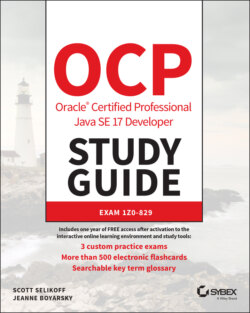Читать книгу OCP Oracle Certified Professional Java SE 17 Developer Study Guide - Jeanne Boyarsky - Страница 85
Ordering Elements in a Class
ОглавлениеNow that you've seen the most common parts of a class, let's take a look at the correct order to type them into a file. Comments can go anywhere in the code. Beyond that, you need to memorize the rules in Table 1.5.
TABLE 1.5 Order for declaring a class
| Element | Example | Required? | Where does it go? |
|---|---|---|---|
| Package declaration | package abc; | No | First line in the file (excluding comments or blank lines) |
import statements | import java.util.*; | No | Immediately after the package (if present) |
| Top-level type declaration | public class C | Yes | Immediately after the import (if any) |
| Field declarations | int value; | No | Any top-level element within a class |
| Method declarations | void method() | No | Any top-level element within a class |
Let's look at a few examples to help you remember this. The first example contains one of each element:
package structure; // package must be first non-comment import java.util.*; // import must come after package public class Meerkat { // then comes the class double weight; // fields and methods can go in either order public double getWeight() { return weight; } double height; // another field - they don't need to be together }
So far, so good. This is a common pattern that you should be familiar with. How about this one?
/* header */ package structure; // class Meerkat public class Meerkat { }
Still good. We can put comments anywhere, blank lines are ignored, and imports are optional. In the next example, we have a problem:
import java.util.*; package structure; // DOES NOT COMPILE String name; // DOES NOT COMPILE public class Meerkat { } // DOES NOT COMPILE
There are two problems here. One is that the package and import statements are reversed. Although both are optional, package must come before import if present. The other issue is that a field attempts a declaration outside a class. This is not allowed. Fields and methods must be within a class.
Got all that? Think of the acronym PIC (picture): package, import, and class. Fields and methods are easier to remember because they merely have to be inside a class.
Throughout this book, if you see two public classes in a code snippet or question, you can assume they are in different files unless it specifically says they are in the same .java file.
Now you know how to create and arrange a class. Later chapters show you how to create classes with more powerful operations.
